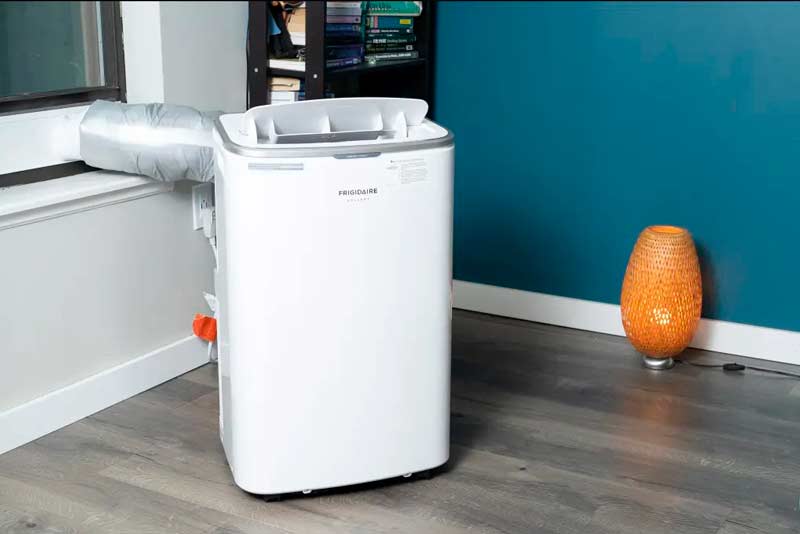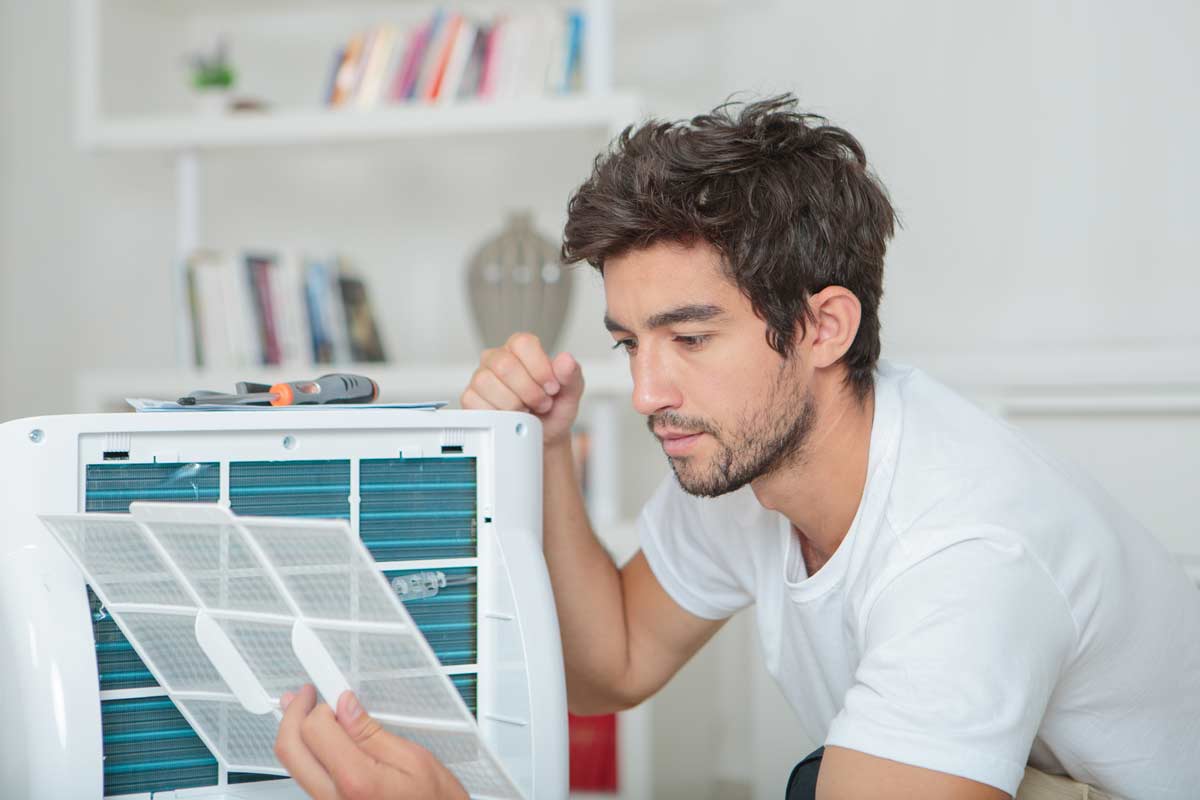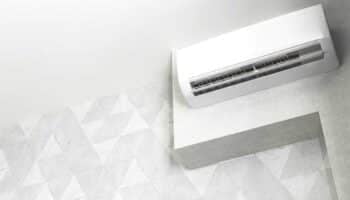We've independently reviewed this article to make sure it's as accurate as we can make it.
To find out more about our article creation and review process, check out our editorial guidelines.
Is your portable air conditioner taking the “ice cold” setting a bit too literally?
If you’ve got an ice cube instead of an air conditioner – don’t worry! I see this frozen air conditioner issue often, especially with portable models.
Portable air conditioners freeze over for a variety of reasons. In my experience, this is often due to dirty coils, refrigerant leaks, dirty filters, or even using too large of a unit for the space you’re trying to cool.
The good news is you can solve a lot of these issues yourself. So keep reading and I’ll walk you through the fixes.
If Your Portable Air Conditioner Freezes Over…
Follow along as I identify the different issues the ice might be a symptom of. I’ll explain what’s happening and what you can do to get your air conditioner back into good working order.
1- Clean or Replace Dirty Air Filters

Changing or cleaning your filters may not seem like a very big deal, but a dirty filter is the cause of countless problems.
Any type of HVAC equipment needs and is designed for a certain amount of airflow. However, filters that aren’t changed regularly have an ever-growing layer of dirt, debris, pet hair, dust, and more.
The deeper that layer gets, the more impossible it is for any air to pass through it. A lack of airflow can cause ice to form on your air conditioner’s internal coils.
Depending on the model of your portable air conditioner, you may have a disposable filter that you’ll need to replace or a reusable filter that you’ll need to clean.
Here’s what you need to do.
Step 1
Access your filter according to the manufacturer’s owner’s manual
Step 2
If your unit has a reusable filter, wipe any of the dirt and dust off with a soft cloth or brush, and then thoroughly wash it with warm water and mild detergent, such as dish soap
Step 3
If your unit has a disposable filter, replace it with a new filter that meets the manufacturer’s specifications
Step 4
If your filter was washable, allow it to completely air dry before putting it back in the air conditioner, as a damp or moist filter will breed mold. At the very least, this will lead to a smelly air conditioner.
If you want to get any replacement part – or see how much one would cost – click to enter your model number in the search bar below. Our partners at AppliancePartsPros stock almost every part with free guides on how to install them.

2- Make Sure It’s Draining Properly
Air conditioners create condensation. That’s part of the process of turning hot air into cool air.
Your portable air conditioner will have at least one reservoir to hold condensation. If you haven’t attached a drainage hose to automate the process, you need to check and drain your AC reservoirs regularly.
If you’re in a humid environment, you may need to do this about every eight hours. Failure to deal with standing water may lead to it eventually freezing solid.
Step 1
Unplug your air conditioner
Step 2
Elevate your air conditioner enough to place the container under the drain. Alternatively, find a very shallow container to put under the drain hole.
Step 3
Unplug the drain hole and allow the water to escape into the container
Step 4
Once done, plug the drain in again and restart the air conditioner.
3- Inspect and Clean Your Coils
Your air conditioner’s condenser and evaporator coils work together to exchange hot air for cool air. Unfortunately, if dirt builds up on your coils they will eventually freeze over and stop doing their job.
The cleaner you keep your air conditioner, the more efficiently it will run. If you allow your air conditioner and its components to get and remain dirty, your air conditioner could stop running entirely.
At the very least, you should clean your coils once a year. Here are the steps.
Step 1
Unplug your air conditioner
Step 2
Dismantle your air conditioner following the guidance of your owner’s manual
Step 3
Access your coils and remove any loose dirt and debris with a shop vac and or a small brush
Step 4
Spray down the coils with coil cleaner following the manufacturer’s directions, being careful not to spray any electronics
Step 5
Allow the spray foam to set for the recommended time, and then use a stiff brush to wipe down the coils. If you selected a non-rinsing coil cleaner, you won’t need to rinse it off.
Step 6
Reassemble your air conditioner and plug it back in
4- Check the Thermostat

Not all portable air conditioners come with a thermostat but if your unit has one this is another possible cause for your air conditioner to freeze over.
If the thermostat is set too low, either deliberately or by mistake, your air conditioner can work too hard to reach and maintain that temperature. This could result in the condensation on the condenser coils freezing up.
Step 1
If you have a thermostat, check to see what the temperature is set at. Most energy companies recommend setting a thermostat in the mid-70s. If yours is set at something significantly lower, try raising it and seeing what impact this has on your air conditioner.
Step 2
If there are no issues with the setting, you may have a faulty thermostat that isn’t allowing your air conditioner to cycle on and off properly. Check to see if there are replacement parts for your air conditioner’s thermostat.
5- Rule out a Refrigerant Leak
There are a few things that might be a symptom of a refrigerant leak. Unfortunately, they are symptoms of several other things as well. If you do suspect a refrigerant leak, this is dangerous and needs to be handled by a professional.
- Your air conditioner can’t keep up — doesn’t cool properly
- Your indoor air is humid
- It’s cycling longer than normal
- Ice is building up on the evaporator coils
Many people believe that they’d be able to hear a refrigerant leak – but in my experience this isn’t true. It’s not got that kind of pressure, instead it’s typically silent. You need specialized equipment to be able to find one easily.
Again, a refrigerant leak is dangerous. If you suspect this is what you’re dealing with call a professional immediately.
Conclusion
In most cases, an air conditioner that is frozen over is something you can address yourself. Unless you have a refrigerant leak — in that case, you must call an HVAC professional or anyone certified to deal with refrigerant.
Once you’ve ruled out a refrigerant leak, to recap, here are the other issues to look for.
- Clean or replace dirty air filters
- Make sure your air conditioner is draining properly
- Inspect and clean your coils
- Check the thermostat
Hopefully, this information has helped to narrow down the cause of the ice on your portable air conditioner.
Thanks for reading through. While you’re here, why not check out some of our related posts listed below? Perhaps we can help you with something else.







